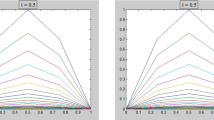Abstract
A discretization of an optimal control problem of a stochastic parabolic equation driven by multiplicative noise is analyzed. The state equation is discretized by the continuous piecewise linear element method in space and by the backward Euler scheme in time. The convergence rate \( O(\tau ^{1/2} + h^2) \) is rigorously derived.
Similar content being viewed by others
References
Baldi, P.: Stochastic Calculus. Springer, Cham (2017)
Barbu, V., Rockner, M.: A splitting algorithm for stochastic partial differential equations driven by linear multiplicative noise. Stoch. Partial Differ. Equ. Anal. Comput. 5, 457–471 (2017) Anal. Comput. 5, 457–471 (2017)
Barth, A., Lang, A.: Milstein approximation for advection-diffusion equations driven by multiplicative noncontinuous martingale noises. Appl. Math. Optim. 66, 387–413 (2012)
Bensoussan, A.: Stochastic maximum principle for distributed parameter systems. J. Franklin Inst. 315, 387–406 (1983)
Bensoussan, A., Viot, M.: Optimal control of stochastic linear distributed parameter systems. SIAM J. Control 13(4), 904–926 (1975)
Bouchard, B., Touzi, N.: Discrete-time approximation and Monte-Carlo simulation of backward stochastic differential equations. Stoch. Process. Appl. 111, 175–206 (2004)
Crisan, D., Manolarakis, K.: Solving backward stochastic differential equations using the cubature method: application to nonlinear pricing. SIAM J. Financial Math. 3, 534–571 (2012)
Cui, J., Hong, J.: Strong and weak convergence rates of a spatial approximation for stochastic partial differential equation with one-sided Lipschitz coefficient. SIAM J. Numer. Anal. 57, 1815–1841 (2019)
Du, K., Meng, Q.: A maximum principle for optimal control of stochastic evolution equations. SIAM J. Control Optim. 51, 4343–4362 (2013)
Du, K., Tang, S.: Strong solution of backward stochastic partial differential equations in \( \cal{C}^2 \) domains. Proba. Theory. Related Fileds 154, 255–285 (2012)
Dunst, T., Prohl, A.: The forward-backward stochastic heat equation: numerical analysis and simulation. SIAM J. Sci. Comput. 38, A2725–A2755 (2016)
Fuhrman, M., Hu, Y., Tessitore, G.: Stochastic maximum principle for optimal control of SPDEs. Appl. Math. Optim. 68, 181–217 (2013)
Hinze, M.: A variational discretization concept in control constrained optimization: the linear-quadratic case. Comput. Optim. Appl. 30, 45–63 (2005)
Hinze, M., Pinnau, R., Ulbrich, M., Ulbrich, S.: Optimization with PDE Constraints. Springer, Netherlands (2009)
Hu, Y., Nualart, D., Song, X.: Malliavin calculus for backward stochastic differential equations and application to numerical solutions. Ann. Appl. Probab. 21, 2379–2423 (2011)
Hu, Y., Peng, S.: Maximum principle for semilinear stochastic evolution control systems. Stoch. Stoch. Rep. 33, 159–180 (1990)
Jentzen, A., R ockner, M. : A Milstein scheme for SPDEs. Found. Comput. Math. 15, 313–362 (2015)
Kruse, R.: Optimal error estimates of Galerkin finite element methods for stochastic partial differential equations with multiplicative noise. IMA J. Numer. Anal. 34, 217–251 (2014)
Li, Y., Tang, S.: Approximation of backward stochastic partial differential equations by a splitting-up method. J. Math. Anal. Appl. 493(1), (2021)
Lu, Q., Zhang, X.: General Pontryagin-type stochastic maximum principle and backward stochastic evolution equations in infinite dimensions. Springer, Cham (2014)
Lu, Q., Zhang, X.: A mini-course on stochastic control. (2016). arXiv:1612.02523,
Lunardi, A.: Interpolation Theory. Edizioni della Normale, Pisa (2018)
Meidner, D., Vexler, B.: A priori error estimates for space-time finite element discretization of parabolic optimal control problems part I: problems without control constraints. SIAM J. Control Optim. 47, 1150–1177 (2008)
Pardoux, E., Rascanu, A.: Stochastic differential equations, backward SDEs, partial differential equations. Springer, Cham (2014)
Peng, S., Xu, M.: Numerical algorithms for backward stochastic differential equations with 1-d Brownian motion: convergence and simulations. ESAIM: M2AN 45(2), 335–360 (2011)
Thomée, V.: Galerkin Finite Element Methods for Parabolic Problems. Springer, Berlin (2006)
Wang, P., Zhang, X.: Numerical solutions of backward stochastic differential equations: a finite transposition method. C. R. Math. Acad. Sci. Paris 349, 901–903 (2011)
Wang, Y.: A semidiscrete Galerkin scheme for backward stochastic parabolic differential equations. Math. Control Relat. Fields 6, 489–515 (2016)
Wang, Y.: L2-regularity of solutions to linear backward stochastic heat equations, and a numerical application. J. Math. Anal. Appl. 486(1), (2020)
Yan, Y.: Galerkin finite element methods for stochastic parabolic partial differential equations. SIAM J. Numer. Anal. 43, 1363–1384 (2005)
Zhang, J.: A numerical scheme for BSDEs. Ann. Appl. Probab. 14, 459–488 (2004)
Zhao, W., Chen, L., Peng, S.: A new kind of accurate numerical method for backward stochastic differential equations. SIAM J. Sci. Comput. 28, 1563–1581 (2006)
Zhao, W., Fu, Y., Zhou, T.: New kinds of high-order multistep schemes for coupled forward backward stochastic differential equations. SIAM J. Sci. Comput. 36, A1731–A1751 (2014)
Zhao, W., Zhou, T., Kong, T.: High order numerical schemes for second-order FBSDEs with applications to stochastic optimal control. Commun. Comput. Phys. 21, 808–834 (2017)
Zhou, X.: On the necessary conditions of optimal controls for stochastic partial differential equations. SIAM J. Control Optim. 31, 1462–1478 (2012)
Author information
Authors and Affiliations
Corresponding author
Additional information
Publisher's Note
Springer Nature remains neutral with regard to jurisdictional claims in published maps and institutional affiliations.
Binjie Li was supported in part by the National Natural Science Foundation of China (11901410).
Proof of Lemma 4.3
Proof of Lemma 4.3
Since (27) can be proved by the same argument as that used in the proof of [23, Theorem 5.1], we only prove (26), using the techniques in the proof of [26, Theorem 12.1]. Let
By (25) we have
Since (24) implies
we obtain
By integration by parts, we then obtain
Combining (112) and (114) yields
Since
it follows that
Hence,
which implies
Therefore, by the standard estimate
we obtain
namely,
Similarly, we can prove
Since \( P_J = \eta (t_J) = 0 \), this proves (26) and thus completes the proof.
Rights and permissions
About this article
Cite this article
Li, B., Zhou, Q. Discretization of a Distributed Optimal Control Problem with a Stochastic Parabolic Equation Driven by Multiplicative Noise. J Sci Comput 87, 68 (2021). https://doi.org/10.1007/s10915-021-01480-5
Received:
Revised:
Accepted:
Published:
DOI: https://doi.org/10.1007/s10915-021-01480-5



